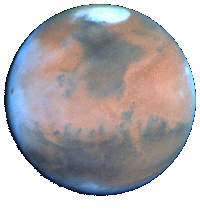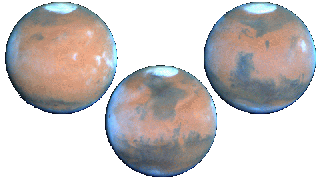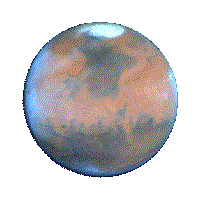|
Mars
The Hubble Space Telescope has trained its eye on Mars since 1990, imaging the planet's surface features and studying
its atmosphere in both visible and ultraviolet light. This image is
the clearest ever taken from Earth. Only the images shot returned by
such Mars-visiting probes as Mars, Mariner and Viking in the 1960s and
1970s show more details.

In this image, taken on February 25, 1995, spring is in full swing in the Martian northern hemisphere. The northern ice
cap, made almost completely of water ice, can be seen quite clearly.
It's a few hundred kilometers across. The cool atmosphere has an
abundance of wispy white clouds, formed when atmospheric water vapor
freezes at night. Mars is cooler, drier and cloudier now than it was
in the years when Mariner, Viking and the Mars probes were charting
the Red Planet.
On the left, the volcano Ascraeus Mons pokes
through the clouds as morning breaks across the western hemisphere of
the planet. In the lower left you can just make out the famed Vallis
Marineris ("the Valley of the Mariners") -- which stretches across an
area of the planet roughly equivalent to the width of the United
States.
Mars may well have supported organic life on its
surface in the very distant past. Recent studies of meteorites from the
planet seem to imply that ancient, primordial life forms once flourished
on the Red Planet. Today no organic life seems to exist on its
surface.
However, this does not mean that Mars is a completely dead planet in other ways. Admittedly, it doesn't look like a
very lively place -- no ongoing volcanic eruptions, flash floods, violent
weather or major earthquakes disturb its peace. However, the dusty red
surface is a Rosetta Stone to Mars' past, and like archaeologists
at a dig, we can use that key to decode the mysteries of Mars' early
years. Mars today does undergo some "Marsquake" activity, mainly in its
northern hemisphere. The giant volcanic mountains were built up from
massive flows that ended perhaps a half a billion years ago.
While there is no surface water now, water did flow at one time, sculpting flow channels across the
Martian surface. This speaks to a thicker atmosphere in the past.
Yet today's Martian atmosphere is thin, mostly carbon dioxide, with
little water. It does, however, change with the seasons, stirring the
surface with winds that spread dust across the plains in striking
lines, reminiscent of Percival Lowell's famous and beloved -- but
non-existent -- "canals."

The Three Faces of Mars
Mars' geologic past lies before us in stark detail. The towering Olympus Mons (covered with a crescent-shaped cloud in the
image on the left) is evidence of extensive early volcanic activity in
the Tharsis Region. The Chryse and Argyre basins in the Valles
Marineris Region (center), and the giant impact basin Syrtis Major
that is the focal point of the Syrtis Major region (right) are
testaments to the surface-altering forces of impacts. The Valles
Marineris is the result of ancient tectonic forces, working from
within the planet to create this huge rift valley.
What we still don't know about Mars is why it has changed from a water-rich world in the past, to the
dry and dusty desert planet we see today. Something changed in Mars'
early days, something that altered the evolution of Mars forever. We
may never find out the secrets of Mars' past, but that does not keep
us from exploring it -- or the other worlds
of our Solar System.

Photos courtesy Philip James (University of Toledo), Steven Lee (University of Colorado), Space Telescope Science Institute, NASA, ESA.
|